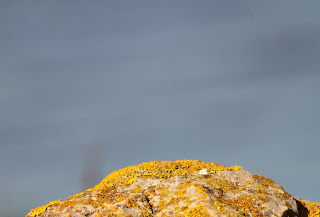I couldn’t get out ringing again this morning, but it looks like Sunday may be a good morning for another try. In the meantime I thought that a walk along the coast checking out a few spots would be the best bet, even though the visible migration of earlier in the week may have begun easing off for now, particularly with the overnight increase to virtually full cloud cover and a strengthening north westerly predicted tomorrow.
I wondered if the decision was the right one when I stepped out of the back door to see a Redwing at the top of the sycamore in my neighbour’s garden. As it turned out, that was the only Redwing I would see in the whole morning.
First I stopped at Wheel Lane for the geese spectacular; who wouldn’t? The early Whooper Swans were back on the scene with 9 of them plus a Mute Swan. The swans were surrounded by Black-headed Gulls and Jackdaws, but encircled by mainly Pink-footed Geese, with good numbers of Greylag, all of them drawn in by the food put down by the wildfowlers. In the massive feeding flock and constant movement it’s pretty nigh impossible to count out the Greylags from the pinkies, but with the numbers here and out on the marsh today my estimate remains at 20,000 geese. That includes 9 Barnacle Geese that were out on the marsh with the majority of the pink-feet.



The Barnacle Goose picture is by John James Audubon the great American naturalist, author of his life's work The Birds of America. This book contained life-sized portraits of 1,065 individual birds, and was published in four volumes between 1827 and 1838. He was a self-taught artist and naturalist, who became a legend for his paintings, which for the first time depicted birds in natural habitats and poses. In 1886 a bird preservation organization took his name and the body later evolved into the National Audubon Society. Audubon also began the first known bird ringing on the American continent: he tied yarn to the legs of Eastern Phoebes and found that they returned to the same nesting spots year after year.
The resident Kestrel hung about at the vantage points near Wheel Lane where I guess all that ground food leads to a more than a few unwary mammals and birds fit for a hungry Kestrel.

I gave Lane Ends a bit of a bashing but all I could find was a couple of Blackbirds, 11 Goldfinch, a Great-spotted Woodpecker, 6 Chaffinch, 6 Robin and from the call, a probable Scandinavian Chiffchaff. There was a second Kestrel here, hunting and hovering around the car park.

I walked towards Pilling but the “vis” was pretty much non-existent, with just a couple of Meadow Pipits and 18 Skylarks overhead and a single Snipe which came off the inland field.
At Pilling Water I counted 7 Little Egret and 1 Grey Heron with 15 Teal and a Greenshank in the outflow channel. But out here on the sea wall were geese in all directions, geese to the left of me, geese to the right of me and geese flying constantly back and forth. Suddenly I remembered the stranger I saw at Lane Ends a few days ago who earnestly asked me about the whereabouts of Lapland Buntings and told me that most of the birders he had met there recently were “only looking at the geese”.

































































.jpg)












